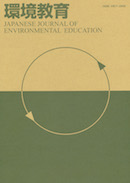28 巻, 4 号
選択された号の論文の12件中1~12を表示しています
- |<
- <
- 1
- >
- >|
Editorial
-
2019 年28 巻4 号 p. 4_1-3
発行日: 2019年
公開日: 2019/07/31
PDF形式でダウンロード (650K)
Research Article
-
2019 年28 巻4 号 p. 4_4-12
発行日: 2019年
公開日: 2019/07/31
PDF形式でダウンロード (698K) -
2019 年28 巻4 号 p. 4_13-20
発行日: 2019年
公開日: 2019/07/31
PDF形式でダウンロード (719K)
Review Article
-
2019 年28 巻4 号 p. 4_21-28
発行日: 2019年
公開日: 2019/07/31
PDF形式でダウンロード (718K)
Research Article
-
2019 年28 巻4 号 p. 4_29-35
発行日: 2019年
公開日: 2019/07/31
PDF形式でダウンロード (689K) -
2019 年28 巻4 号 p. 4_36-43
発行日: 2019年
公開日: 2019/07/31
PDF形式でダウンロード (742K)
Report
-
2019 年28 巻4 号 p. 4_44-51
発行日: 2019年
公開日: 2019/07/31
PDF形式でダウンロード (731K) -
2019 年28 巻4 号 p. 4_52-59
発行日: 2019年
公開日: 2019/07/31
PDF形式でダウンロード (819K)
Research Article
-
2019 年28 巻4 号 p. 4_60-67
発行日: 2019年
公開日: 2019/07/31
PDF形式でダウンロード (734K) -
2019 年28 巻4 号 p. 4_68-76
発行日: 2019年
公開日: 2019/07/31
PDF形式でダウンロード (769K) -
2019 年28 巻4 号 p. 4_77-84
発行日: 2019年
公開日: 2019/07/31
PDF形式でダウンロード (702K)
Epilogue
-
2019 年28 巻4 号 p. 4_85-88
発行日: 2019年
公開日: 2019/07/31
PDF形式でダウンロード (632K)
- |<
- <
- 1
- >
- >|
